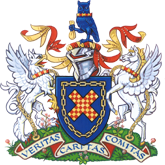Surveying Taxes in the Great War 1914-1918
An attentive audience enjoyed the History of Tax Group lecture presented by David Williams in the Council Room at King's College London on 1st October 2012. David, a liveryman of the Tax Advisers, started his career as an Inspector of Taxes before becoming a tax partner at Smith & Williamson. David has written articles for the British Tax Review and the "Quarterly Record" (the former magazine of the Union of Senior Revenue Officials) on tax administration in the early 20th century. David is also a Member of the First Tier of the Tax Tribunal.
His topic was " Surveying Taxes in the Great War 1914-1918". David undertook to fill in the Tax Analysis so lacking in recent episodes of Downton Abbey! The title "Surveyor of Taxes" precedes "Inspector of Taxes", the latter only arising in 1919. The presentation skilfully wove the passage of the war with the ensuing tax developments, including some poignant visual aids such as the Somme Battlefield, a sketch of a Surveyor serving at the front and the Somerset House war memorial.
1913/14 - on the eve of war, the effective rate of tax actually suffered on national income of all kinds was 3.72%. At the outbreak of war income tax was raised to 5.83% and a supertax was imposed on incomes in excess of £5k. Surveyors were regarded as carrying out essential war work. By November 1914, the war was costing £1m a day and the effective rate of tax was up to 12.5%. The government encouraged the purchase of war loan.
1915 - The cost of the war rose to £2m a day and the army at the front was suffering from a shortage of shells. Lloyd George was put in charge of Munitions and introduced the Munitions Levy a new "impost" as opposed to a tax. During this year Excess Profits Duty (EPD) was introduced at 50% and was assessed by the local Surveyor. Many workers fell into the income tax net for the first time due to overtime payments, so a system of quarterly payments was introduced to help them budget. Surveyors were still considered as carrying out essential war work.
1916 - Women were recruited to the Revenue and could earn as much as £3 a week, a wage pitched high to compete with the private sector. Male clerks could now sign up for the war, though Surveyors were still considered essential to the war effort. By April the war was costing £3.75m a day, and income tax was at 25% with EPD at 60%.
1917 - The Revenue acquired 80 specialist accountants. Munitions Levy was merged with EPD and the rate on this merged tax was raised to 80%. War loan interest was to be paid gross at 5%. This year also saw a miners' tax strike in South Wales, demanding the end to "tax on overtime". There was a further push in some quarters to have Surveyors conscripted.
1918 - The standard rate of tax was now 30%, super tax was 22.5% and EPD was producing £300m a year. 81 Surveyors under the age of 24 were released for the front, but too late to see any action before the war ended. David explained that the tax take was at 6 times its pre war level.
The audience raised many questions afterwards, not least one from a Treasury attendee who was particularly interested in EPD! Discussions continued in the Moot Court in the newly restored Somerset House East Wing over a glass of wine and at nearby Fernandez and Wells over supper. I am sure that everyone who attended the event would like to thank David Williams for a most illuminating and entertaining evening.
Morag Loader
October 2012
